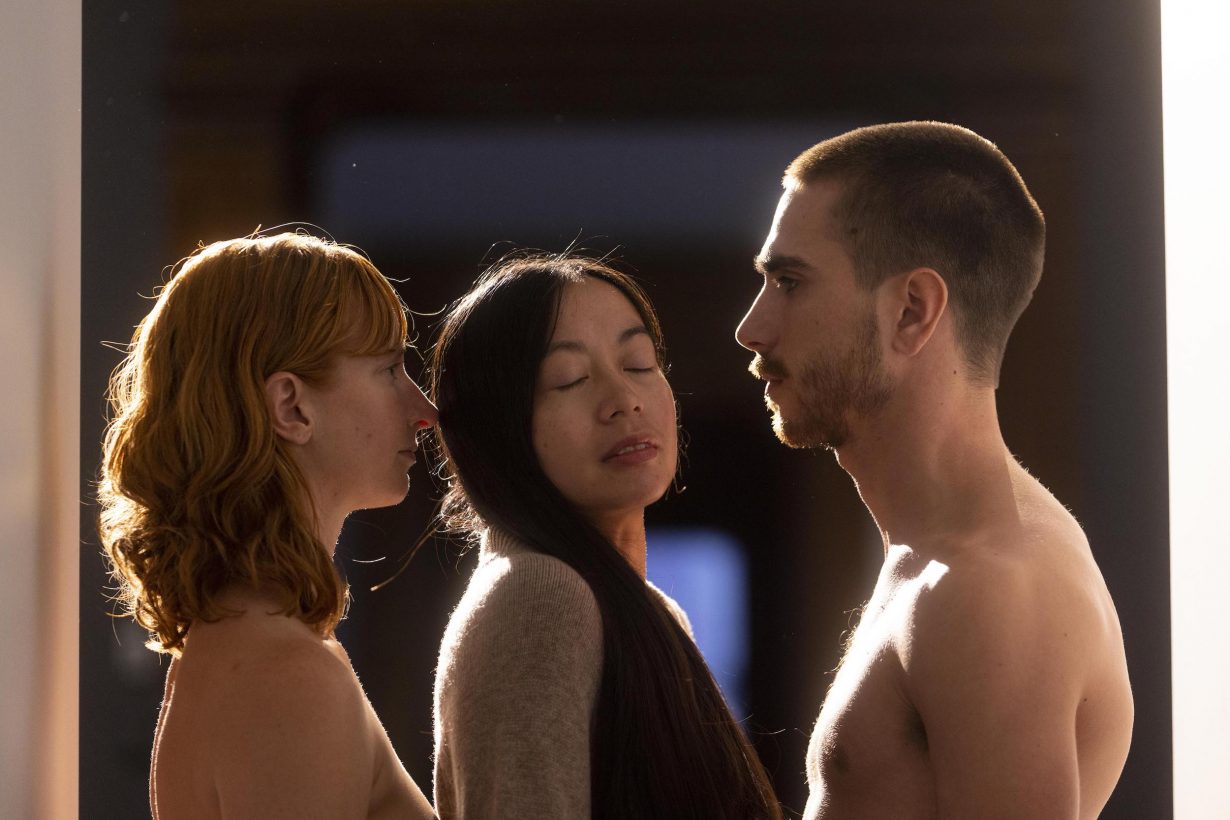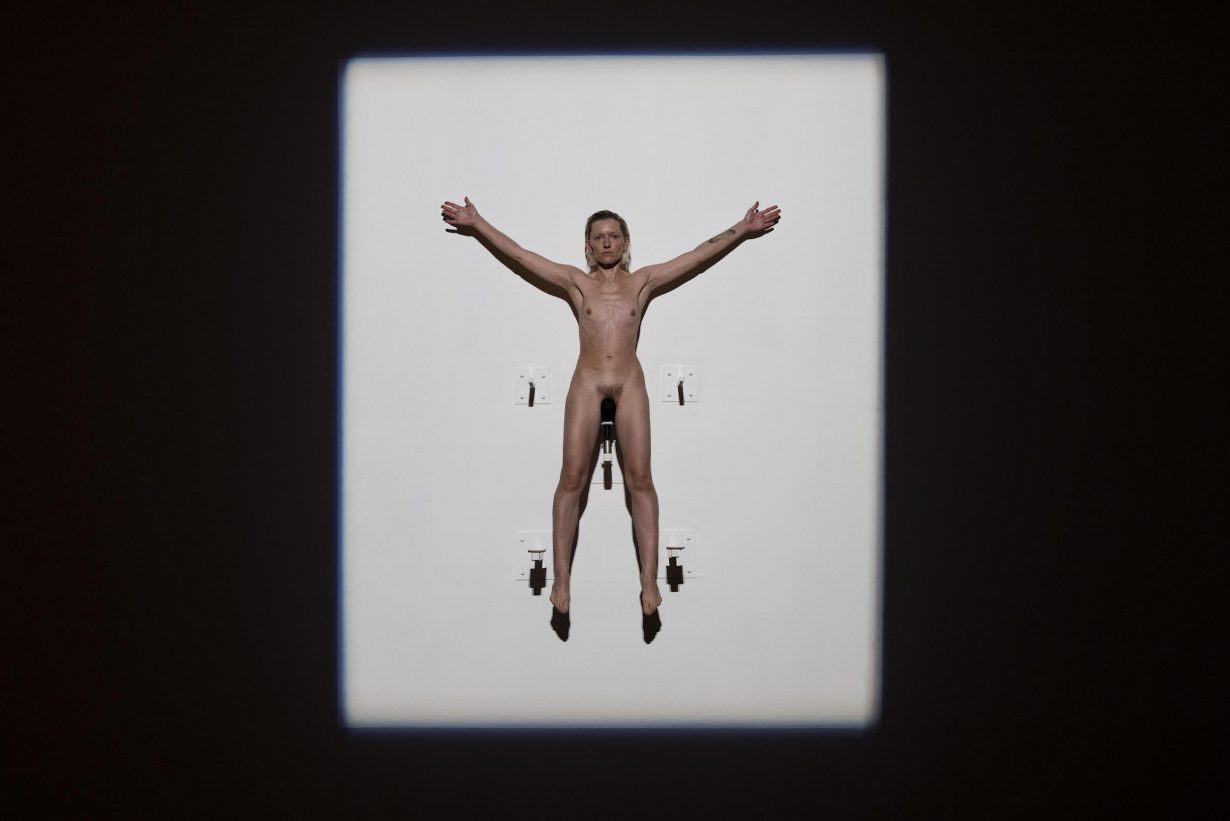The first retrospective of a woman artist’s work at the main galleries of the Royal Academy in London is as much a history of the audience as it is the artist
Initially, what we encounter here is a retrospective of an audience. In the first room, projected onto the wall, are 74 videos each showing a member of the public as they sat opposite Marina Abramović during The Artist is Present at MoMA in New York in 2010. Some of these faces are recognisable (I see the artist and actor Jemima Kirke at the centre, another is definitely Colm Tóibín, we know that Lou Reed, Björk and James Franco also visited) and their inclusion reminds us of Abramović’s happy co-existence with celebrity. She has collaborated with Jay-Z (on a music video), Givenchy (creatively directing their runaway) and Lady Gaga (whom she blindfolded, starved and instructed on her ‘method’), for example. It might be surprising that the ‘godmother of performance art’, whose career spins a tale of transgression against the body, is so at ease in the standardised, protected and bodily ‘perfect’ world of celebrity. But celebrity is drawn to her and she does not resist – celebrities, perhaps, enjoy her insistence on alarming a public they must curtail themselves for. She is of use to them. A singular space where bravery without the constraints of self-regard is queen. And Abramović will always allow herself to be put to use.
However, the first retrospective of a woman artist’s work to be staged at the main galleries of the Royal Academy is not earnt through famous friends, nor through a career of simply unremitting shock. And so we come back to those 74 faces (famous and not) who are crying, or smiling; even in those with blanker expressions, there is a general sense that something inexpressible is dawning on them. They are reacting to something. Something as basic perhaps as being looked at and completely accepted as they are. Something quite primal. The way the ideal mother should look at you. They project themselves onto her, wanting intensity; finding no judgment in return, nothing to be ashamed of, they find they came to cry.
Facing them on the opposite wall are 74 videos of Abramović as she looked back at each participant. These are less mesmeric; they are uniform, the only changeable factor is the colour of her turtleneck and her blinking eyes – your eye follows her blinks as they ripple over the wall. Her questions, the ones that have accompanied her practice since its earliest iterations: What is it that you’ll do to me? What is it that you want to show me? I can take it all. So, tell me, what are you here?

The next room is given over to Rhythm 0, a six-hour performance first staged at Studio Morra in Naples in 1972. (These are Abramović’s instructions which accompanied the original piece: ‘There are 72 objects on the table that one can use on me as desired. Performance. I am the object. During this period I take full responsibility.’) On a table at this remembering of the work are some of the objects that Abramović left out for her audience to do whatever they wished with. A copy of Corriere della Sera, three pairs of scissors, bell, hat, medal, rose, gun. Seven bright knives. An axe longer than my arm. A saw as wide as my thigh. Projected on the walls are 69 slides from the performance. These show the eagerness of the young art crowd that surrounded her. She is stripped and written on. People laughing. Their fingers in her mouth. She is chained up and surrounded by men who have their hands in their pockets. A man’s belly held in by his belt.
The slides are incriminating. The accompanying text points out that when the performance ended, and Abramović moved of her own volition, the public ‘fled’. Unremembered here are the people who protected her when one man held a loaded gun to her clavicle. Nor are we told that, as Abramović put it in her memoir Walk Through Walls (2016), ‘the women in the gallery would tell the men what to do to me, rather than do it themselves’. But, nonetheless, it is an insight into the artist’s audience: forcing their projections onto her physically, frightened by what they could do to her, frightened by how quickly social morals break down and the safe plane of the human psyche can betray its crazy fragility, when we see the body as an object. A look too into a very specific audience and a specific time and place: Catholic Southern Italy in the 70s, charged with sexuality. The Madonna/whore complex.
This insight into a different public is repeated at the RA with a reperformance of Imponderabilia (first staged at the Galleria Communale d’Arte Moderna, Bologna, 1977) in which Abramović and her then-partner Ulay stood naked and facing each other for audience members to pass between. At the restaging of this work by two of the 38 performance artists involved in this retrospective and ‘trained in the Marina Abramović method’, it’s clear how narrow the entranceway is and was, it’s impossible to walk through without touching the naked bodies. (A guard and a man in a white lab coat stand nearby.) Abramović originally accompanied this work with a text noting: ‘The overriding importance of imponderables determining human conduct’.

Beside the current recreation of Imponderabilia is a video of the original. You can watch the people from 1977 on screen as they pass between Abramović and Ulay, alongside the people passing through their stand-ins today. The word for how the public moved through in 1977 is: brusquely. Today, we are entreated in self-examination (Couples’ Therapy, TikToks about narcissism, Instagrammers who specialize in complex PTSD, Esther Perel, consent education) and we scrutinise shame. We know that when shame is left unexamined it is accompanied by perfectly equal amounts of violence. When a person is ashamed – of their desires, their sexuality, their self – we have learnt that they are more likely to intrude, move brusquely, to dehumanise for the fun of the evening. On the day I visited the RA, and this is anecdotal, the younger visitors were going around the work (an option), not through it. This is not, as one critic had it, ‘cheating’. It’s indicative of a certain self-selecting audience, in a certain age – born since these kinds of works and their questions were ripped off, repeated and entered the atmosphere.
Once we’ve gone through (or around) Imponderabilia, the retrospective shifts from a view of the audiences who have in the past made the work, to an experiment with the present audience. There are reperformances of Nude with Skeleton (2005) and The House with the Ocean View (2002). There is a room of work hewn from crystals, stones that hold ‘vast quantities of geological and human energy’ (a theme seized upon by the gift shop). These are Transitory Objects for Human Use. In Black Dragon (1990) you may lay against three mineral pillows, one for your head, one for the heart and one for the sex. (The black quartz and brown agate in these sculptures satisfyingly seems to repeat in the old doorways of the Royal Academy.)

The final room is set up for The House with the Ocean View where the performance artists Elke Luyten, Kira O’Reilly and Amanda Coogan will each spend 12 days. They were not in situ on my visit, but there was a small crowd gathering in the room. Some excitement in the air. A specific time and place: London, in the 2020s, charged with a type of anticipation that’s probably more akin to daily dread than Catholicism. Each day and each audience: a brand new proposition. Abramović contains in her memory and her physical scars a 40-year history of the changing public. Now we enter her domain with our concealable intrusive camera phones. Two security guards had come in to discuss the grey tape demarcating a certain space on the floor. People waited deliberately. Eventually, no less than six guards and staff were present. A man and a woman entered, both in white lab coats. She took her coat off and climbed a ladder, naked, to the bicycle seat suspended high on the wall. She rearranged her pubis, and when she was centred, she released her legs into points and the ladder was removed. This is Luminosity (1997/2023). The light on her is astonishingly bright. The guards move their gaze through the crowd, expertly, looking people in the eye; no one would get away with a photo or coming too close. It displays a protection that Abramović never had. And this was her stated wish: that the performance artists taking her place be well looked after.
Abramović has planned her own funeral. In Walk Through Walls she says there will be three graves in three different countries and no one will know which marks the resting place of her body. The artist I saw take Abramović’s place for Luminosity first elicited in me an unguarded fear for her wellbeing, but then, in her face, I saw a kind of power which was not about domination. Nor submission. More like an eternal, natural force expressed through human form. Perhaps my projection. It’s like visiting a Christ. The artist is not present, but, oh, everywhere.
Roz Dineen’s debut novel Briefly Very Beautiful will be published by Bloomsbury in 2024.
